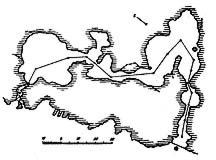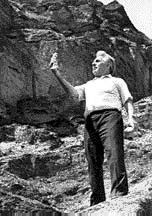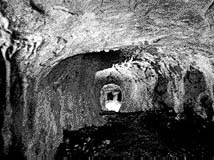
Summer 1996 (4.2)
Jawbones and
Dragon Legends
Azerbaijan's
Prehistoric Azikh Cave
by Dr. Arif Mustafayev

 Mammadali
Huseinov, Azerbaijani archeologist with the jawbone of a prehistoric
"Azikh Woman" which he discovered in 1968. It has been
confirmed to be 350 to 400 thousand years old.
Mammadali
Huseinov, Azerbaijani archeologist with the jawbone of a prehistoric
"Azikh Woman" which he discovered in 1968. It has been
confirmed to be 350 to 400 thousand years old.
In 1968, Azerbaijani paleontologist, Mammadali Huseinov,
(1922-1994) discovered a lower jawbone of Early Man which turned
out to be one of the Neanderthal type. It has since been analyzed
independently in the West and confirmed to be between 350,000-400,000
years old. The jawbone, with one molar totally intact and another
partially broken, is believed to have belonged to a female about
18 years old. (In those days, she would have been considered
"old" as the average life span is believed to have
been about 20-22 years). In the cave where the jawbone was found-Azikh
Cave-tools chipped and carved out of stone were found dating
back to the Paleolithic and Mesolithic periods which would make
them between 1-1.5 million years old.

Plan of Azikh Cave which is about 8,000 square meters and
contains maze-like passageways that extend nearly 600 meters
through eight large hallways or grottos.Oldest Human Relic
in Former USSR

 According to the
French paleontologist, Lumlee, the Azikh jawbone is the fourth
oldest human relic ever to be found in history. The first was
discovered by Richard Leakey (his wife, Mary, and son) in Olduvai
Gorge, Tanzania. The second, in Kenya; and the third, in France.
Huseinov's discovery is the oldest ever identified in the entire
former Soviet Union.
According to the
French paleontologist, Lumlee, the Azikh jawbone is the fourth
oldest human relic ever to be found in history. The first was
discovered by Richard Leakey (his wife, Mary, and son) in Olduvai
Gorge, Tanzania. The second, in Kenya; and the third, in France.
Huseinov's discovery is the oldest ever identified in the entire
former Soviet Union.
"Azikh Man"-one of the earliest inhabitants on earth
once populated the region now known as Azerbaijan. It's one of
Azerbaijan's best-kept secrets. Not many people outside of Azerbaijan
or the former Soviet Union know about it.
Huseinov named these prehistoric people, "Azikh Anthropos",
because they inhabited the cave known as Azikh Cave near the
Azikh River on the southeastern slope of the Little Caucasus
mountain range in southwestern Azerbaijan. The cave is close
to the Iranian border near the town of Fuzuli. Currently, the
region is under military occupation by Armenians. All Azerbaijanis
have fled the area since 1993 (See Side Bar: "Want to Visit
Azikh Cave?").
One of Huseinov's greatest disappointments in life was that since
the late 1980s, he was not able to continue his research in the
Azikh Cave because of the military threats and war in the region.
Until his last days he had not lost hope that the region would
be liberated from Armenian occupation. He died in 1994 at the
age of 72, his dreams still not realized.

 Mammadali Huseinov,
archeologist, in front of Azikh Cave considered to be the earliest
cave ever inhabited in the region of the former Soviet Union.
Stone tools date back to 1.5 million years to 730,000 years ago.
Mammadali Huseinov,
archeologist, in front of Azikh Cave considered to be the earliest
cave ever inhabited in the region of the former Soviet Union.
Stone tools date back to 1.5 million years to 730,000 years ago.
One of the reasons the international
community doesn't know much about "Azikh Man," is that
Huseinov didn't get a chance to travel abroad much. He was not
a member of the Communist Party; furthermore, he had been captured
by the Germans during World War II and, incredible as it may
seem, prisoners of war were treated with suspicion after they
were released. Many of them, in fact, were exiled to Siberia.
Foreigners rarely got the chance to visit or collaborate with
him about his work. He did manage, however, to develop a fairly
close relationship with the French scientist, Lumlee. Huseinov
relied on information he read in Russian journals and magazines
to stay informed about developments in the field.
Huseinov was the first archeologist ever to discover Paleolithic
relics in Azerbaijan. Before him, no one imagined that Paleolithic
man (also known as Stone Age Man) had lived in the Transcaucasus
two million years earlier.
Huseinov's work as an archeologist was successful from the beginning.
In 1953, as a university graduate, he organized an expedition
into the Kazakh region in the northwestern tip of Azerbaijan
near Armenia and Georgia. He found many artifacts spanning the
Aeneolithic (5,000-4,000 BC) to the Bronze Age (3,000-2,000 BC)
in the region.

 Interior of Azikh
Cave in the Southwestern part of Azerbaijan. The cave is believed
to have been inhabited as early as one million years ago. The
cave contains fourteen meters of cultural deposits relating to
different periods of mid-Paleolithic period. It was discovered
in 1968 by Mammadali Huseinov.
Interior of Azikh
Cave in the Southwestern part of Azerbaijan. The cave is believed
to have been inhabited as early as one million years ago. The
cave contains fourteen meters of cultural deposits relating to
different periods of mid-Paleolithic period. It was discovered
in 1968 by Mammadali Huseinov.
Legends About
the Cave
But it was Azikh Cave
that Huseinov called his "masterpiece". His discovery
came in 1960. People of the Karabakh region nearby knew about
the cave. Many legends were told about how it was a dangerous
place-inhabited by dragons. Those who entered were not expected
to come out alive. One tale that was widespread described how
a flock of sheep had wandered inside the cave and been eaten
alive by dragons.
Azikh is quite sizable. It is the largest limestone cave ever
found in the Caucasus and extends through maze-like passageways
for nearly 600 meters. The cave comprises a total area of about
8,000 square meters and includes eight large hallways or grottos,
some with very high domed ceilings reaching up to 20-25 meters.
Stalactite and stalagmite columns can be found throughout the
cavern.
Huseinov concluded that Azikh Cave had been inhabited over a
period of, perhaps, tens of thousands of years, as there were
fourteen meters of cultural deposits (archaeological debris)
that comprised ten distinct archeological layers relating to
different periods of mid-Paleolithic period in the cave.
One of Huseinov's unique findings was the primitive work stones,
which in archeological terms, represent a river stone culture.
He called that period the Kuruchai Culture as the Azikh Cave
is located in the Kuruchai River basin. The only other known
civilization equivalent to Kuruchai Culture dates back 1.5 million
years to the Olduvai Gorge in Tanzania. Huseinov believed the
Kuruchai Culture dated from between 1.5 million years to 730,000
years ago.
As is true of many cave settlements, bones of various animals
were found; 45 distinct species have been identified, some of
which are now extinct. After fire was introduced, it seems that
most animal bones were burned. From all indications cave bears
and various species of deer were the pride of the hunt.

 Cave
Tools
Cave
Tools
Religious Significance
of Bear
The cave bear seemed
to have religious significance for the Azikh people. A hiding
place was discovered in the Acheulian layer near the hearths
where skulls of the bears were laid out. All the skulls had been
severed in a similar way. Both the upper and lower jaws were
missing. In one case, two jawbones cut in halves formed a cross.
In another case, a cross was repeated graphically, and in another,
a crossed notch was found among other notches on one of the skulls.
No such phenomena had ever been known for other relics of this
period.
First Fire Places
in the History of Mankind
One of the most important
findings in the 4th stratum dealt with the history of making
fire. Under the influence of hunting, people began to make artificial
hearths by digging pits in the ground and encircling them with
masonry or semicircular bars.
The area designated to hold the fire is rather shallow and seems
to have been used not only for cooking meat but also for preserving
fire artificially. Such a finding would indicate serious changes
had taken place in the life of these ancient peoples, separating
them from other living beings. This was the last discovery that
Huseinov made in relation to Azikh cave.
Between 1972-73, five fireplaces were discovered in different
stratigraphic levels. One was surrounded by a crescent-like stone
wall foundation 30 centimeters thick. This wall was built to
protect the living area from sparks. It is the first known construction
in the history of humankind and first known fire place. It most
probably dates to the period 700,000-500,000 years ago. Of particular
interest is the fact that the hearths exist during different
periods on the same site, important evidence for the continuity
of traditions.
No Evidence of
Life - 4th Stratum
A rather strange phenomenon
was discovered in the 4th stratum (Acheulian period). In this
layer, no evidence of human life was found. For some reason,
it seems the inhabitants left the cave only to return to dwell
there later on.
The question, of course, is why. This phenomenon is evidenced
in other caves, as well. Could it have been that an upper section
of the cave had collapsed and people were afraid to enter? Or
had an accident occurred? Some archeologists suggest that after
the Ice Age, the climate became warmer and people no longer needed
to stay inside; as they could live more openly in settlements.
Huseinov's work was never recognized or given any state or national
prize. He loved his work and didn't expect external awards. His
students deeply admired and respected him. It is his dedicated
research , however, that has proved beyond a doubt that the area
now known as Azerbaijan was one of the earliest known cradles
of civilization.
Arif Mustafayev is Professor of Archeology at Baku State
University. He worked with Mohammadali Huseinov in the Academy
of Sciences for 25 years.
Want to Visit Azikh
Cave?
Want to visit Azikh
Cave-prehistoric home of "Azikh Anthropos" who lived
at least 300,000-350,000 years ago? You'll have to wait awhile.
These days it's impossible.
Azikh cave is located in southwestern Azerbaijan close to the
Iranian border near the town, Fuzuli, in the Kuruchai Valley
on the southeastern slope of the Little Caucasus mountains. It's
in a region which was captured in 1993 by Armenians and which
is being held militarily. Currently, 20 percent of Azerbaijan's
territory in the western part of the country has been captured
by Armenian forces. The occupied territory includes Nagorno-Karabakh,
a mountainous enclave inside Azerbaijan which Armenians are trying
to develop as an independent Republic, as well as much of the
surrounding territory.
The Nagorno Karabakh Conflict began in 1988. There has been a
cease-fire for the past two years, but up until then, thousands
of Azerbaijanis and Armenians have been killed in a war that
has been fought entirely on Azerbaijani soil. More than one million
Azerbaijanis have since fled and evacuated the occupied regions.
Displaced in their own homeland, many of them are trying to survive
in improvised shelters and "tent camps" that have been
set up by humanitarian agencies as close to their original communities
as is possible.
Azerbaijanis are hopeful that a peace agreement will be signed
soon that will give them the right to return to regions inside
their own country and rebuild their communities and their broken
lives. When the peace comes, then visits to Azikh Cave will be
possible-if landmines haven't been scattered throughout the region.
Home | About
Azeri | Learn
Azeri | Arabic
Script | Store | Contact
us
Articles from Azerbaijan
International
© Azerbaijan International. Copyright 2002. All rights reserved.
|
|